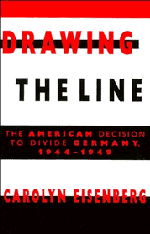Book contents
- Frontmatter
- Contents
- Preface and Acknowledgments
- Germany – Occupation Zones, 1945
- Introduction: Private Polowsky's Oath
- 1 Plans
- 2 Making Peace
- 3 The Limits of Reform: The U.S. Zone
- 4 A Fragile Friendship
- 5 The Russian Challenge
- 6 Bizonal Beginnings
- 7 The Doctors Deliberate
- 8 Marshall's Medicine
- 9 A Separate State
- 10 Cold War Germany
- 11 Winning
- Conclusion: The American Decision to Divide Germany
- Bibliography
- Index
9 - A Separate State
Published online by Cambridge University Press: 07 October 2009
- Frontmatter
- Contents
- Preface and Acknowledgments
- Germany – Occupation Zones, 1945
- Introduction: Private Polowsky's Oath
- 1 Plans
- 2 Making Peace
- 3 The Limits of Reform: The U.S. Zone
- 4 A Fragile Friendship
- 5 The Russian Challenge
- 6 Bizonal Beginnings
- 7 The Doctors Deliberate
- 8 Marshall's Medicine
- 9 A Separate State
- 10 Cold War Germany
- 11 Winning
- Conclusion: The American Decision to Divide Germany
- Bibliography
- Index
Summary
You know of the sincere and patient attempts of the democratic nations to find a secure basis for peace through negotiation. … You know of the obstacles we have encountered. But the record stands as a monument to the good faith and integrity of the democratic nations of the world.
(Harry S. Truman, March 17, 1948)… we may be approaching agreement in the ACC on quadripartite currency reform for all of Germany. The question arises whether this is desirable from the U.S. standpoint. … it is recommended that General Clay be instructed that the policy of this government is no longer to reach agreement on currency and financial reform.
(Frank G. Wisner, Deputy to the Assistant Secretary of State for Occupied Areas, March 10, 1948)By the beginning of 1948 the Americans and British were resolved: There would be two Germanies. For the foreseeable future the eastern zone would be left to the Russians, while the western zones would become a separate state. Together the two powers devised concrete plans for making West Germany a reality: procedures for a constituent assembly, guidelines for a governmental structure, arrangements for the Ruhr, and provisions for a diminished occupation.
The Anglo-American initiatives generated significant opposition from France and other West European nations, who remained fearful of German militarism. Meanwhile West German politicians, whose cooperation was essential to the project, were loathe to endorse measures that would formally divide their country. From these currents emerged a new and serious dilemma for policy makers: to assuage West European anxieties would aggravate the already discontented Germans, whereas to conciliate the Germans could further jeopardize West European support.
Information
- Type
- Chapter
- Information
- Drawing the LineThe American Decision to Divide Germany, 1944–1949, pp. 363 - 410Publisher: Cambridge University PressPrint publication year: 1996
